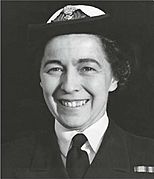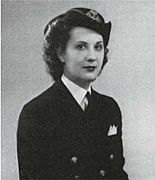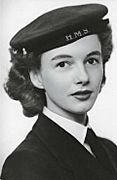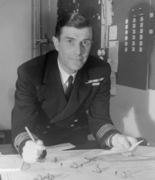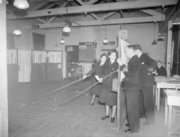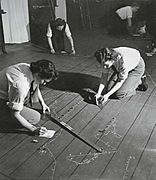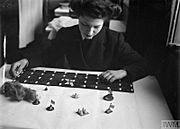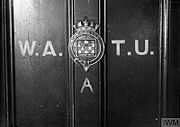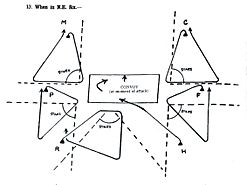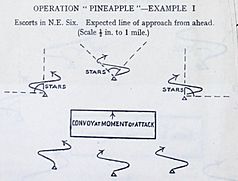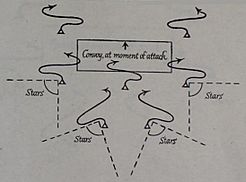Western Approaches Tactical Unit facts for kids
The Western Approaches Tactical Unit (WATU) was a special team of the British Royal Navy. It started in January 1942 during World War II. Its main job was to create and share new ways to fight German submarines, called U-boats. These submarines were attacking ships crossing the Atlantic Ocean.
Captain Gilbert Roberts led WATU. Most of the team were women from the Women's Royal Naval Service (known as Wrens). They used special war games to study how U-boats attacked and to figure out how to stop them. After the U-boat threat was defeated, WATU kept making new anti-submarine plans for later parts of the war, like Operation Overlord (the D-Day landings) and the Pacific War. WATU also trained naval officers in these new tactics using week-long war game courses. The unit officially closed at the end of July 1945.
Contents
Why WATU Was Needed
During World War I, German submarines (U-boats) sank many merchant ships in the Atlantic. These ships carried important supplies to Britain. Britain started grouping merchant ships into large groups called convoys. Warships with depth charges (underwater bombs) protected these convoys. This plan worked well against the U-boats.
However, between the two World Wars, Germany secretly developed new submarine tactics. They created "wolfpack" tactics, where groups of submarines attacked convoys together. They also made new, better submarines. Britain, on the other hand, didn't study submarine warfare much during this time. When World War II began, they thought U-boats would fight the same way as before. They didn't know Germany had new tricks.
Britain declared war on Germany on September 3, 1939. Right away, Germany sent its U-boats to attack ships crossing the Atlantic. The attacks were very damaging. In 1938, Britain received 68 million tons of imports. By 1941, U-boats had cut this to only 26 million tons. Britain needed imports to survive. If the attacks continued, they would run out of food and supplies. In March 1941, Prime Minister Winston Churchill called this struggle "the Battle of the Atlantic." Stopping the U-boats became the most important goal.
The Royal Navy knew from secret radio messages that U-boats were working in groups. But they didn't know exactly how. On January 1, 1942, Admiral Cecil Vivian Usborne asked Commander Gilbert Roberts to start a war-gaming team. This team would be at the Western Approaches Command in Liverpool. Its job was to study U-boat attacks and create ways to defend against them. Roberts had designed naval war games before. He was also good at teaching commanders the new tactics he would develop.
Roberts moved to Liverpool and set up his team on the top floor of the Western Approaches headquarters. This officially began on February 23, 1942. Most of the staff at Western Approaches were women from the Women's Royal Naval Service (Wrens). Roberts also hired most of his team from the Wrens. A total of sixty-six Wrens worked at WATU from 1942 to 1945.
Roberts and his team looked at battle reports from convoy escort commanders. They recreated the battles using war games to understand how the U-boats were attacking. Then, they invented tactics for the escort ships to defeat the U-boats. Their first new tactic was called Raspberry (see below). Besides creating tactics, WATU also trained naval officers. The officers learned by playing the war games themselves. The training course lasted six days, from Monday to Saturday. It was held every week from February 1942 until July 1945. Up to fifty officers took the course at a time. WATU trained officers not only from Britain but also from Canada, the United States, New Zealand, Norway, South Africa, Poland, and Free France.
In May 1943, Admiral Karl Dönitz ordered the U-boats to leave the Atlantic. This allowed merchant convoys to pass safely.
By 1944, people knew about WATU. A journalist visited WATU in January 1944 and wrote a short article. A bigger story appeared in Illustrated magazine the next month.
WATU continued to develop anti-submarine tactics and train officers until the war ended. It officially closed at the end of July 1945. It had trained almost 5,000 officers during its time.
WATU's Impact
After WATU closed, Admiral Horton sent a message to its former members. He thanked Captain Roberts and his team for their "magnificent work." He said their work helped a lot in defeating Germany. Admiral Noble also wrote to Roberts, saying he had a "great deal to do in winning the war." He added that if they hadn't won the Battle of the Atlantic, they would have lost the war.
WATU is important in the history of military wargaming. It was one of the first times war games were used to solve real problems in a war that was still happening. Before WATU, most war games were played during peacetime. They helped officers prepare for possible wars or studied old battles. WATU's success was possible because of new communication tools like radio and telephone.
The training course from WATU is mentioned in the 1951 book The Cruel Sea. The author, Nicholas Monsarrat, had attended WATU during the war. WATU's role in the Battle of the North Atlantic is also shown in the 2022 TV series 'U-Boat Wargamers'. This series also highlights how much the Royal Navy Wrens helped make WATU successful.
Where WATU Was Based
Western Approaches Command was a part of Britain's Royal Navy. Its job was to protect British ships in the Western Approaches. These were the seas west of Ireland and Britain. At first, its headquarters was in Plymouth, on Britain's southern coast. But in February 1941, it moved north to Liverpool. After France fell to the Germans, ships crossing the North Atlantic had to go around the north of Ireland to avoid the German navy. Moving the command to Liverpool made communications faster.
WATU's headquarters was in Derby House, a building behind Liverpool's town hall. Today, the headquarters is a museum. The top floor, with eight rooms, was given to WATU. Most of the staff at Western Approaches HQ were women from the Women's Royal Naval Service, known as "Wrens." When Roberts arrived in January 1942, Admiral Percy Noble was the commander-in-chief. Admiral Max Horton replaced him in November 1942.
Who Worked at WATU
A total of sixty-six women from the Women's Royal Naval Service (Wrens) worked at WATU from 1942 to 1945. Here are some of the key people:
- Captain Gilbert Roberts - He was the director of WATU. He used to command a destroyer. But he got tuberculosis in 1938 and couldn't serve at sea anymore.
- Mary Poole - A WRNS officer. She was the first female officer to take the WATU training course.
- Laura Janet Howes - A WRNS officer. She was born in Antigua and was very good at math. Her nickname was "Bobby."
- Elizabeth Drake - A WRNS officer. She was already working at Derby House as a plotter when WATU started.
- Nancy Wales - A WRNS officer. She was born in Kingston upon Hull and joined the Wrens in 1941. She loved playing hockey and was chosen for her understanding of team tactics.
- Jean Laidlaw - A WRNS officer. She was from Scotland, a former Sea Ranger, and an accountant.
- Janet Okell - A WRNS rating (a non-officer rank). She was only 19 when she joined WATU in January 1942. She stayed at WATU for the entire war. Janet was first trained to plot ship movements. But soon, she was playing in the war games, commanding both U-boats and escort ships.
- June Duncan - A WRNS rating. She was one of WATU's longest-serving members.
How the War Games Worked
Gilbert Roberts first learned about war gaming at the Portsmouth Tactical School from 1935 to 1937. Roberts loved war gaming and made up his own rules. His games were based on games created by Fred T. Jane in 1898. Even though U-boats were a big problem in World War I, Roberts' games at Portsmouth didn't include submarine warfare or attacks on merchant convoys. In fact, no one in the Royal Navy studied submarine warfare with war games until WATU started in 1942.
At WATU, the war games took place in the biggest room on the top floor of the headquarters. The floor had a brown covering with a grid painted on it. This grid was the game board, or "tactical table." The grid lines were ten inches apart, representing one nautical mile (about 1.15 miles). Around the grid were tall canvas screens with small holes. The players who controlled the escort ships had to stand behind these screens. They could only see the game board through the peepholes. The players who controlled the U-boats did not stand behind screens and could see the whole board.
Small wooden models represented the ships and U-boats on the board. The U-boats' paths were drawn with green chalk. This color was hard to see against the brown floor, especially from an angle. This meant the players behind the screens couldn't easily see the U-boat movements. The escort ships' paths were drawn with white chalk, which was easy for everyone to see.
Players had two minutes per turn to make decisions and give orders. They wrote their orders on pieces of paper and gave them to the Wrens. This stopped their opponents from hearing their plans. The Wrens would then get down on the floor and calculate what happened based on the orders. They would draw the ships' paths with chalk. Roberts gave the Wrens all the details about the ships: how far U-boat torpedoes could go, ship speeds, how fast they could turn, how well the escorts' sonar (called ASDIC back then) worked, how engine noise might affect listening, and how well they could see at night.
Tactics Developed by WATU
The Raspberry Maneuver
During World War I, U-boats usually attacked convoys from the outside. But in 1942, reports showed U-boats were sinking ships in the middle of the convoy. Roberts thought U-boats were somehow sneaking inside without being seen. Roberts and his team tried different ways a U-boat might do this in their war games. Only one way worked: The U-boat snuck into the convoy from the back, on the surface of the water. Being on the surface let it use its diesel engine to go faster than the convoy. Since these attacks happened at night, and lookouts usually focused on the front, the U-boat was hard to spot. Once inside the convoy, it looked just like other ships on radar. The U-boat would then sink a merchant ship with a torpedo from close range, then dive underwater to escape.
Roberts and his team created the Raspberry maneuver to counter this. If an escort ship saw a convoy ship get torpedoed, it would fire two white rockets. Then, it would say "raspberry" over the radio to start the maneuver. Any escort ships at the front of the convoy would keep going straight and fire star shells (flares that light up the area). The escort ships at the back and sides of the convoy would speed towards the convoy at 15 knots (about 17 miles per hour). One rear escort would sweep the very back of the convoy. The other escorts, once they reached the edge of the convoy, would turn around and sweep away from the convoy. They would fire star shells for 10 to 12 minutes. Then they would turn back to their starting positions. While doing all this, all the ships would fire star shells outwards to light up the water's surface.
Raspberry was likely an improved version of an earlier maneuver called Buttercup. Buttercup was created by Frederic J. Walker, another escort commander. The Admiralty (the Royal Navy's command) criticized Buttercup because not all escorts searched in all directions. In Buttercup, escorts only searched the side of the convoy where the attack was thought to come from. This meant the U-boat could escape if the commander guessed wrong. Also, only the escort commander could order Buttercup, which could cause a dangerous delay. In contrast, Raspberry had all escorts search the entire area, and any escort could order the maneuver.
Jean Laidlaw suggested the name Raspberry, meaning to "blow a raspberry" at Hitler.
The Raspberry maneuver was stopped in May 1943.
The Pineapple Maneuver
Pineapple was designed as an alternative to Raspberry and Banana. It was used when more than one U-boat was attacking a convoy. It had four main goals:
- Make a second U-boat dive before it could attack.
- Give a chance to find a U-boat that had already fired torpedoes.
- Stop another U-boat from seeing the convoy in any light used to find the attacking U-boat.
- Increase the chance of finding any submerged U-boat about to attack and create a bigger barrier in the attack area.
If a ship was torpedoed, any escort would fire two white rockets and say "pineapple" over the radio to start the maneuver. Depth charges would be set to a shallow pattern of ten charges. The escorts would keep moving forward in zigzag patterns that were 2 miles wide. They would search for U-boats using sonar, radar, and star shells. The escorts facing the expected direction of the second U-boat would fire star shells away from the convoy to find it. They were told not to fire star shells into the convoy. Escorts on the opposite side of the convoy were not to fire star shells at all. This was probably to avoid lighting up the convoy, which would make it easy for a second U-boat to spot.
The Banana Maneuver
Banana was for when a single U-boat attacked the convoy. It replaced Raspberry, along with Pineapple.
If a merchant ship was torpedoed, the escort would fire two white rockets and signal "banana" over the radio. Then, it would start sweeping with sonar and radar at the fastest possible speed. The rear escorts would fire star shells outwards. Then, they would move into the convoy to sweep with sonar in a zigzag pattern. The first of these escorts to reach the torpedoed ship's wreckage would carry out a search pattern called Operation Observant. The escorts on the sides of the convoy would sweep towards the rear until they were even with the rear escorts. After that, they would turn around and sweep forward in a zigzag pattern. The forward escorts would sweep forward in a zigzag pattern.
The Beta Search Maneuver
Beta Search was a way for an escort ship to find a U-boat it had seen following a convoy. The manual for escort commanders said that a single escort had a low chance of finding and destroying a U-boat. But by guessing the most likely path the U-boat would take and searching nearby, the chances of success could be improved. Beta Search was an improvement on an earlier maneuver called Alpha Search, developed by Commander Frederic Walker. The advantage of Beta Search was that it encouraged the U-boat to move in a specific direction. The downside was that the escort ship needed "special plotting equipment" to use it.
In Alpha Search, the escort turns directly towards the U-boat, which makes the U-boat dive. The escort then turns 20 degrees. When the escort reaches the U-boat's "furthest towards" circle (a calculated point), it changes course towards where the U-boat dived, moving in a zigzag pattern with short legs. After passing the dive location, the escort drops a marker in the water. Then it continues zigzagging for the same distance. Finally, it turns 90 degrees towards the convoy and starts a search pattern called Operation Observant.
In Beta Search, the escort turns towards the U-boat, but not directly at it. The U-boat would likely react by diving and moving parallel to the convoy. The escort then moves towards the U-boat's predicted position along that path (this would be at about a 15-degree angle from where the U-boat was first seen). When the escort reaches the U-boat's "furthest towards" circle, it starts "zigzagging with short legs." When the escort crosses the U-boat's predicted escape line, it drops a sea marker in the water. When the escort reaches the U-boat's "furthest away" circle, it turns 90 degrees towards where the U-boat dived and begins Operation Observant.
The Step Aside Maneuver
Step Aside was a tactic for a warship to attack a U-boat that had acoustic torpedoes. These were special torpedoes, like the German T5 Zaunkönig (called GNAT by the Royal Navy). This torpedo used built-in hydrophones (underwater microphones) to find its target by sound. It was drawn to the sound of a ship's propeller. The first time this torpedo was used was on September 20, 1943, against convoy ON 202. The Royal Navy already knew about German acoustic torpedoes from questioning captured Germans and decoding messages. In the attack on ON 202, a frigate (a type of warship) was hit in the back while it was heading towards the U-boat. This could only happen with a homing torpedo.
Roberts and his team at WATU developed Step Aside. In this maneuver, the warship makes sharp turns to dodge the acoustic torpedoes the U-boat might fire as the warship gets close enough to attack. Step Aside was sent by radio to escort commanders at sea on September 23, 1943.
Step Aside was for warships that couldn't go faster than 24 knots (about 27.6 miles per hour) and didn't have special Foxer decoys (devices to trick acoustic torpedoes). Most convoy escorts were frigates and corvettes, which had a top speed of 16 to 20 knots. The T5 torpedo moved at 24 knots. So, faster ships like destroyers could just outrun the torpedo.
If a U-boat was seen within 6,000 yards (about 3.4 miles), the ship would head straight for the U-boat at its fastest speed for 2 minutes. The U-boat was expected to fire its acoustic torpedo when it saw the ship coming straight at it. After 2 minutes, the ship would turn 60 degrees left or right and hold this new course for 3 minutes. This would put it outside the torpedo's detection range. Then, the ship would turn to head straight for the U-boat again. If the U-boat hadn't dived yet, the ship would repeat the maneuver: sail towards the U-boat for 2 minutes, then turn 60 degrees, and so on. The warship would repeat this until the U-boat dived. When the U-boat dived, the ship would rush to where it went down, then slow down to search using sonar.
See also
- Rodger Winn


